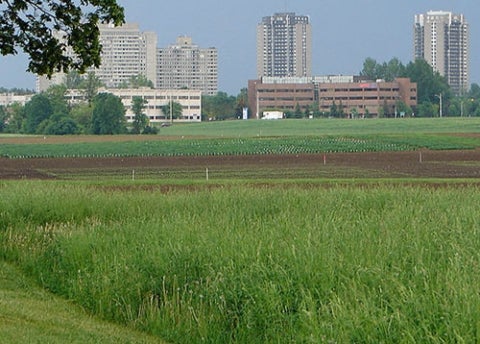Note: Yale School of the Environment (YSE) was formerly known as the Yale School of Forestry & Environmental Studies (F&ES). News articles and events posted prior to July 1, 2020 refer to the School's name at that time.
Population density will be a critical factor in determining how much energy is needed to cool and heat buildings in the world’s urban areas by mid-century, according to a new study co-authored by Yale Prof. Karen Seto.
The role of density will play a particularly important part in the world’s developing nations, with important implications for greenhouse gas emissions and global sustainability.
The role of density will play a particularly important part in the world’s developing nations, with important implications for greenhouse gas emissions and global sustainability.
Growth of Mega-Cities Will Consume Swaths of Cropland in Africa and Asia
 <small>The growth of mega-cities will eliminate massive areas of valuable cropland in some parts of the world by the year 2030, according to a new study co-authored by Karen Seto, Professor of Geography and Urbanization Science. <a href="http://environment.yale.edu/news/article/growth-of-megacities-will-consume-swaths-of-cropland-in-africa-and-asia/">Read more</a></small>
<small>The growth of mega-cities will eliminate massive areas of valuable cropland in some parts of the world by the year 2030, according to a new study co-authored by Karen Seto, Professor of Geography and Urbanization Science. <a href="http://environment.yale.edu/news/article/growth-of-megacities-will-consume-swaths-of-cropland-in-africa-and-asia/">Read more</a></small>
Writing in the Proceedings of the National Academy of Sciences, the researchers evaluate a series of possible scenarios of future urbanization — including different potential outcomes in terms of spatial development — and estimated the energy implications of these outcomes.
Specifically, they looked at energy use for heating and cooling of buildings in different regions of the world.
According to their analysis, a trend toward more “compact” urbanization development and more advanced energy efficiency technologies would increase energy use by about 7 percent. But if development occurs in more dispersed manner, and technologies don’t advance in their efficiencies, energy use could spike by as much as 40 percent.
“I was surprised by the results: increasing urban density reduces energy use more than increasing energy efficiency in many developing regions such as China,” said Seto, Professor of Geography and Urbanization Science at the Yale School of Forestry & Environmental Studies. “This means that cities have a lot at their disposal in terms of policies and strategies to reduce energy use beyond investing in new technologies.”
The study was led by Burak Güneralp, a research assistant professor in the Department of Geography at Texas A&M University.
The researchers predict that China, Europe, and North America will account for the majority of future cumulative energy use for heating and cooling through 2050.
Specifically, they looked at energy use for heating and cooling of buildings in different regions of the world.
According to their analysis, a trend toward more “compact” urbanization development and more advanced energy efficiency technologies would increase energy use by about 7 percent. But if development occurs in more dispersed manner, and technologies don’t advance in their efficiencies, energy use could spike by as much as 40 percent.
“I was surprised by the results: increasing urban density reduces energy use more than increasing energy efficiency in many developing regions such as China,” said Seto, Professor of Geography and Urbanization Science at the Yale School of Forestry & Environmental Studies. “This means that cities have a lot at their disposal in terms of policies and strategies to reduce energy use beyond investing in new technologies.”
The study was led by Burak Güneralp, a research assistant professor in the Department of Geography at Texas A&M University.
The researchers predict that China, Europe, and North America will account for the majority of future cumulative energy use for heating and cooling through 2050.
Cities have a lot at their disposal in terms of policies and strategies to reduce energy use beyond investing in new technologies.
Evidence suggests that urban regions in the developing world can gain a lot in energy savings by encouraging higher urban densities, the authors conclude.
In developed regions, the introduction of energy efficiency technologies — including retrofitting energy systems in aged buildings — will play an equally important role. That is also true in China, where many poorly constructed buildings have been erected in recent years.
“Buildings, as any other infrastructure investment, typically stay in service for decades,” said Güneralp, the lead author of the study. “The energy performance of buildings can be improved through retrofitting but it is much harder to change the layout of a neighborhood let alone of an entire city once it is in place.
“It is more preferable to have our cities develop in energy-efficient forms and using energy-efficient technologies to get it right the first time rather than trying to correct retroactively, which is almost always more expensive, most of the time prohibitively so.”
In developed regions, the introduction of energy efficiency technologies — including retrofitting energy systems in aged buildings — will play an equally important role. That is also true in China, where many poorly constructed buildings have been erected in recent years.
“Buildings, as any other infrastructure investment, typically stay in service for decades,” said Güneralp, the lead author of the study. “The energy performance of buildings can be improved through retrofitting but it is much harder to change the layout of a neighborhood let alone of an entire city once it is in place.
“It is more preferable to have our cities develop in energy-efficient forms and using energy-efficient technologies to get it right the first time rather than trying to correct retroactively, which is almost always more expensive, most of the time prohibitively so.”
– Kevin Dennehy kevin.dennehy@yale.edu 203 436-4842
Published
January 11, 2017